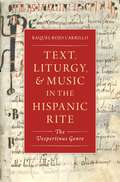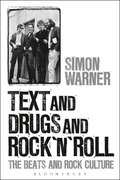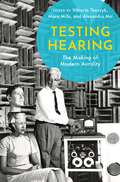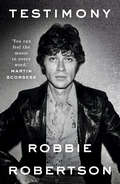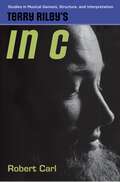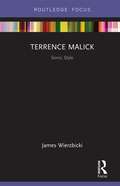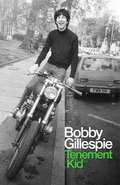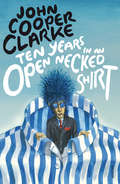- Table View
- List View
Text, Liturgy, and Music in the Hispanic Rite: The Vespertinus Genre (Currents in Latin American and Iberian Music)
by Raquel Rojo CarrilloThe Hispanic rite, a medieval non-Roman Western liturgy, was practiced across the Iberian Peninsula for over half a millennium and functioned as the most distinct marker of Christian identity in this region. As Christians typically began every liturgical day throughout the year by singing a vespertinus, this chant genre in particular provides a unique window into the cultural and religious life of medieval Iberia. The Hispanic rite has the largest corpus of extant manuscripts of all non-Roman liturgies in the West, which testifies to the importance placed on their transmission through political and cultural upheavals. Its chants, however, use a notational system that lacks clear specification of pitch and has kept them barred from in-depth study. Text, Liturgy and Music in the Hispanic Rite is the first detailed analysis of the interactions between textual, liturgical, and musical variables across the entire extant repertoire of a chant genre central to the Hispanic rite, the vespertinus. By approaching the vespertini through a holistic methodology that integrates liturgy, melody, and text, author Raquel Rojo Carrillo identifies the genre's norms and traces the different shapes it adopts across the liturgical year and on different occasions. In this way, the book offers an unprecedented insight into the liturgical edifice of the Hispanic rite and the daily experience of Christians in medieval Iberia.
Text, Liturgy, and Music in the Hispanic Rite: The Vespertinus Genre (Currents in Latin American and Iberian Music)
by Raquel Rojo CarrilloThe Hispanic rite, a medieval non-Roman Western liturgy, was practiced across the Iberian Peninsula for over half a millennium and functioned as the most distinct marker of Christian identity in this region. As Christians typically began every liturgical day throughout the year by singing a vespertinus, this chant genre in particular provides a unique window into the cultural and religious life of medieval Iberia. The Hispanic rite has the largest corpus of extant manuscripts of all non-Roman liturgies in the West, which testifies to the importance placed on their transmission through political and cultural upheavals. Its chants, however, use a notational system that lacks clear specification of pitch and has kept them barred from in-depth study. Text, Liturgy and Music in the Hispanic Rite is the first detailed analysis of the interactions between textual, liturgical, and musical variables across the entire extant repertoire of a chant genre central to the Hispanic rite, the vespertinus. By approaching the vespertini through a holistic methodology that integrates liturgy, melody, and text, author Raquel Rojo Carrillo identifies the genre's norms and traces the different shapes it adopts across the liturgical year and on different occasions. In this way, the book offers an unprecedented insight into the liturgical edifice of the Hispanic rite and the daily experience of Christians in medieval Iberia.
Text and Drugs and Rock 'n' Roll: The Beats and Rock Culture
by Simon WarnerText and Drugs and Rock'n'Roll explores the interaction between two of the most powerful socio-cultural movements in the post-war years - the literary forces of the Beat Generation and the musical energies of rock and its attendant culture.Simon Warner examines the interweaving strands, seeded by the poet/novelists Jack Kerouac, Allen Ginsberg, William Burroughs and others in the 1940s and 1950s, and cultivated by most of the major rock figures who emerged after 1960 - Bob Dylan, the Beatles, Bowie, the Clash and Kurt Cobain, to name just a few.This fascinating cultural history delves into a wide range of issues: Was rock culture the natural heir to the activities of the Beats? Were the hippies the Beats of the 1960s? What attitude did the Beat writers have towards musical forms and particularly rock music? How did literary works shape the consciousness of leading rock music-makers and their followers? Why did Beat literature retain its cultural potency with later rock musicians who rejected hippie values? How did rock musicians use the material of Beat literature in their own work? How did Beat figures become embroiled in the process of rock creativity? These questions are addressed through a number of approaches - the influence of drugs, the relevance of politics, the effect of religious and spiritual pursuits, the rise of the counter-culture, the issue of sub-cultures and their construction, and so on. The result is a highly readable history of the innumerable links between two of the most revolutionary artistic movements of the last 60 years.
Text and Drugs and Rock 'n' Roll: The Beats and Rock Culture
by Simon WarnerText and Drugs and Rock'n'Roll explores the interaction between two of the most powerful socio-cultural movements in the post-war years - the literary forces of the Beat Generation and the musical energies of rock and its attendant culture.Simon Warner examines the interweaving strands, seeded by the poet/novelists Jack Kerouac, Allen Ginsberg, William Burroughs and others in the 1940s and 1950s, and cultivated by most of the major rock figures who emerged after 1960 - Bob Dylan, the Beatles, Bowie, the Clash and Kurt Cobain, to name just a few.This fascinating cultural history delves into a wide range of issues: Was rock culture the natural heir to the activities of the Beats? Were the hippies the Beats of the 1960s? What attitude did the Beat writers have towards musical forms and particularly rock music? How did literary works shape the consciousness of leading rock music-makers and their followers? Why did Beat literature retain its cultural potency with later rock musicians who rejected hippie values? How did rock musicians use the material of Beat literature in their own work? How did Beat figures become embroiled in the process of rock creativity? These questions are addressed through a number of approaches - the influence of drugs, the relevance of politics, the effect of religious and spiritual pursuits, the rise of the counter-culture, the issue of sub-cultures and their construction, and so on. The result is a highly readable history of the innumerable links between two of the most revolutionary artistic movements of the last 60 years.
Testing Hearing: The Making of Modern Aurality
by Viktoria Tkaczyk, Mara Mills, and Alexandra HuiTesting Hearing: The Making of Modern Aurality argues that the modern cultural practices of hearing and testing have emerged from a long interrelationship. Since the early nineteenth century, auditory test tools (whether organ pipes or electronic tone generators) and the results of hearing tests have fed back into instrument calibration, human training, architecture, and the creation of new musical sounds. Hearing tests received a further boost around 1900 as a result of injury compensation laws and state and professional demands for aptitude testing in schools, conservatories, the military, and other fields. Applied at large scale, tests of seemingly small measure-of auditory acuity, of hearing range-helped redefine the modern concept of hearing as such. During the twentieth and twenty-first centuries, the epistemic function of hearing expanded. Hearing took on the dual role of test object and test instrument; in the latter case, human hearing became a gauge by which to evaluate or regulate materials, nonhuman organisms, equipment, and technological systems. This book considers both the testing of hearing and testing with hearing to explore the co-creation of modern epistemic and auditory cultures. The book's twelve contributors trace the design of ever more specific tests for the arts, education and communication, colonial and military applications, sociopolitical and industrial endeavors. Together, they demonstrate that testing as such became an enduring and wide-ranging cultural technique in the modern period, one that is situated between histories of scientific experimentation and many fields of application.
Testing Hearing: The Making of Modern Aurality
Testing Hearing: The Making of Modern Aurality argues that the modern cultural practices of hearing and testing have emerged from a long interrelationship. Since the early nineteenth century, auditory test tools (whether organ pipes or electronic tone generators) and the results of hearing tests have fed back into instrument calibration, human training, architecture, and the creation of new musical sounds. Hearing tests received a further boost around 1900 as a result of injury compensation laws and state and professional demands for aptitude testing in schools, conservatories, the military, and other fields. Applied at large scale, tests of seemingly small measure-of auditory acuity, of hearing range-helped redefine the modern concept of hearing as such. During the twentieth and twenty-first centuries, the epistemic function of hearing expanded. Hearing took on the dual role of test object and test instrument; in the latter case, human hearing became a gauge by which to evaluate or regulate materials, nonhuman organisms, equipment, and technological systems. This book considers both the testing of hearing and testing with hearing to explore the co-creation of modern epistemic and auditory cultures. The book's twelve contributors trace the design of ever more specific tests for the arts, education and communication, colonial and military applications, sociopolitical and industrial endeavors. Together, they demonstrate that testing as such became an enduring and wide-ranging cultural technique in the modern period, one that is situated between histories of scientific experimentation and many fields of application.
Testimony
by Robbie RobertsonRobbie Robertson's singular contributions to popular music have made him one of the most beloved songwriters and guitarists of his time. With songs like ‘The Weight’, ‘The Night They Drove Old Dixie Down’ and ‘Up on Cripple Creek’, he and his partners in the Band fashioned a music that has endured for decades, influencing countless musicians.In this captivating memoir, written over five years of reflection, Robbie employs his unique storyteller's voice to weave together the journey that led him to some of the most pivotal events in music history. He recounts the adventures of his half-Jewish, half-Mohawk upbringing on the Six Nations Indian Reserve and on the gritty streets of Toronto; his odyssey at sixteen to the Mississippi Delta, the fountainhead of American music; the wild, early years on the road with rockabilly legend Ronnie Hawkins and the Hawks; his unexpected ties to the Cosa Nostra underworld; the gripping trial-by-fire of 'going electric' with Bob Dylan on his 1966 world tour and their ensuing celebrated collaborations; the formation of the Band and the forging of their unique sound, culminating with history’s most famous farewell concert, brought to life for all time in Martin Scorsese’s great movie The Last Waltz. This is the story of a time and place - the moment when rock 'n' roll became life, when legends like Buddy Holly and Bo Diddley crisscrossed the circuit of clubs and roadhouses from Texas to Toronto, when the Beatles, Hendrix, the Stones and Warhol moved through the same streets and hotel rooms. It’s the story of exciting change as the world tumbled through the '60s and early '70s and a generation came of age, built on music, love and freedom. Above all, it’s the moving story of the profound friendship among five young men who together created a new kind of popular music. Testimony is Robbie Robertson’s story, lyrical and true, as only he could tell it.
Terry Riley's In C (Studies in Musical Genesis, Structure, and Interpretation)
by Robert CarlSetting the stage for a most intriguing journey into the world of minimalism, Robert Carl's Terry Riley's In C argues that the work holds its place in the canon because of the very challenges it presents to "classical" music. Carl examines In C in the context of its era, its grounding in aesthetic practices and assumptions, its process of composition, presentation, recording, and dissemination.
Terry Riley's In C (Studies in Musical Genesis, Structure, and Interpretation)
by Robert CarlSetting the stage for a most intriguing journey into the world of minimalism, Robert Carl's Terry Riley's In C argues that the work holds its place in the canon because of the very challenges it presents to "classical" music. Carl examines In C in the context of its era, its grounding in aesthetic practices and assumptions, its process of composition, presentation, recording, and dissemination.
Terrence Malick: Sonic Style (Filmmakers and Their Soundtracks)
by James WierzbickiIn the course of a decades-spanning career as a filmmaker, Terrence Malick has carved out a distinctive cinematic aesthetic. Central to this style is the use of sound. James Wierzbicki offers the first comprehensive study of Malick's soundtracks, arguing that they create a distinctive sonic style throughout his oeuvre and exploring how that style functions. Considering voice, noise, and music as elements in the soundtrack, this concise book enriches our understanding of one of our most philosophical filmmakers, and of the interplay between the sonic and visual elements in film.
Terrence Malick: Sonic Style (Filmmakers and Their Soundtracks)
by James WierzbickiIn the course of a decades-spanning career as a filmmaker, Terrence Malick has carved out a distinctive cinematic aesthetic. Central to this style is the use of sound. James Wierzbicki offers the first comprehensive study of Malick's soundtracks, arguing that they create a distinctive sonic style throughout his oeuvre and exploring how that style functions. Considering voice, noise, and music as elements in the soundtrack, this concise book enriches our understanding of one of our most philosophical filmmakers, and of the interplay between the sonic and visual elements in film.
Tenement Kid: Rough Trade Book of the Year
by Bobby GillespieTenement Kid is Bobby Gillespie's story up to the recording and release of the album that has been credited with 'starting the 90's', Screamadelica.Born into a working class Glaswegian family in the summer of 1961, Bobby's memoirs begin in the district of Springburn, soon to be evacuated in Edward Heath's brutal slum clearances. Leaving school at 16 and going to work as a printers' apprentice, Bobby's rock n roll epiphany arrives like a bolt of lightning shining from Phil Lynott's mirrored pickguard at his first gig at the Apollo in Glasgow. Filled with 'the holy spirit of rock n roll' his destiny is sealed with the arrival of the Sex Pistols and punk rock which to Bobby, represents an iconoclastic vision of class rebellion and would ultimately lead to him becoming an artist initially in the Jesus and Mary Chain then in Primal Scream.Structured in four parts, Tenement Kid builds like a breakbeat crescendo to the final quarter of the book, the Summer of Love, Boys Own parties, and the fateful meeting with Andrew Weatherall in an East Sussex field. As the '80s bleed into the '90s and a new kind of electronic soul music starts to pulse through the nation's consciousness, Primal Scream become the most innovative British band of the new decade, representing a new psychedelic vanguard taking shape at Creation Records.Ending with the release of Screamadelica and the tour that followed in the autumn, Tenement Kid is a book filled with the joy and wonder of a rock n roll apostle who would radically reshape the future sounds of fin de siècle British pop. Published thirty years after the release of their masterpiece, Bobby Gillespie's memoir cuts a righteous path through a decade lost to Thatcherism and saved by acid house.
Ten Years in an Open Necked Shirt
by John Cooper Clarke‘Yes, it was be there or be square as, clad in the slum chic of the hipster, he issued the slang anthems of the zip age in the desperate esperanto of the bop. John Cooper Clarke: the name behind the hairstyle, the words walk in the grooves hacking through the hi-fi paradise of true luxury’Punk. Poet. Pioneer. The Bard of Salford’s seminal collection is as scabrous, wry & vivid now as it was when first published over 25 years ago. ‘The godfather of British performance poetry’Daily Telegraph

